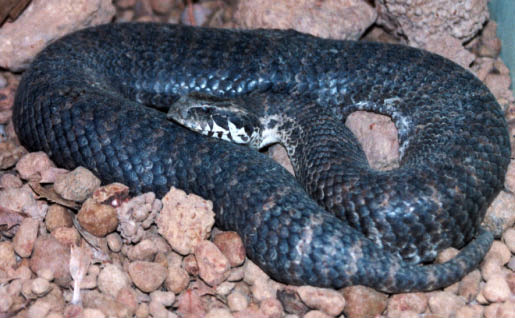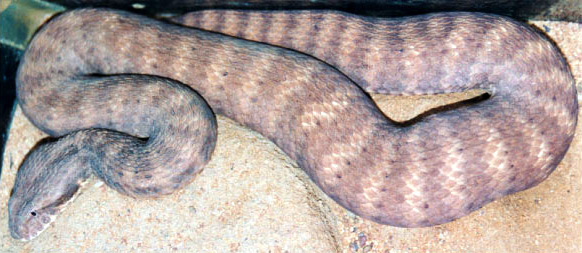Poisonous snakes of Australia
Venomous Snakes
Southern Death Adder

COMMON NAME: Southern Death Adder
SCIENTIFIC NAME: Acanthophis antarcticus
Maximum length: 100 cm.
Venomous:Category 5.
Desert Death Adder

COMMON NAME: Desert Death Adder
SCIENTIFIC NAME: Acanthophis pyrrhus
Maximum length: 75 cm.
Venomous: Category 5.
Pilbara Death Adder

COMMON NAME: Pilbara Death Adder
SCIENTIFIC NAME: Acanthophis wellsi
Maximum length: 70 cm.
Venomous: Category 5.
Western Tiger Snake

COMMON NAME: Western Tiger Snake
SCIENTIFIC NAME: Notechis scutatus
Maximum length: 160 cm.
Venomous: Category 5.
Mulga Snake

COMMON NAME: Mulga Snake
SCIENTIFIC NAME: Pseudechis australis
Maximum length: 300 cm.
Venomous: Category 5.
Spotted Mulga Snake

COMMON NAME: Spotted Mulga Snake
SCIENTIFIC NAME: Pseudechis butleri
Maximum length: 180 cm.
Venomous: Category 5.
Dugite

COMMON NAME: Dugite
SCIENTIFIC NAME: Pseudonaja affinis affinis
Maximum length: 180 cm.
Venomous: Category 5.
Gwardar

COMMON NAME: Gwardar
SCIENTIFIC NAME: Pseudonaja nuchalis
Maximum length: 100 cm.
Venomous: Category 5.
NOTE: All species listed here are dangerously venomous and are listed as Category 5. Only the experienced herpetoculturalist should consider keeping any of them. One must be over 18 years of age to hold a category 5 license. Maintaining a large elapid carries with it a considerable responsibility. Unless you are confident that you can comply with all your obligations and licence requirements when keeping dangerous animals, then look to obtaining a non-venomous species instead.
NATURAL HABITS
Venomous snakes occur in a wide variety of habitats and, apart from death adders, are highly mobile.
All species are active day and night.
HOUSING
In all species listed except death adders, one adult (to 150 cm total length) can be kept indoors in a lockable, top-ventilated, all glass or glass-fronted wooden vivarium of at least 90 x 45 cm floor area. The height should be a minimum of 30 cm if front opening and 45 cm if top opening. Adult death adders require less room, 50 x 30 cm floor area being adequate, but for safety it is preferable to use a top opening vivarium to house these rapidstriking snakes. It is recommended that all venomous snakes be housed separately (except during mating) to avoid problems associated with removal for cleaning, or when feeding. Juveniles (less than 40 cm long) may be kept in smaller facilities. It is very important that cages be strongly constructed, escapeproof and kept locked.
CAPTIVE ENVIRONMENT
Furnishings should be kept simple. Try not to clutter up the cage too much. The floor covering should be easily removed for cleaning.
Some alternatives are newspaper, pea-gravel, woodchips and indoor-outdoor loop-pile carpet. Do not use sand or soil, as this is unsuitable and will harbour disease-causing pathogens. Provide an enclosed shelter such as a wooden constructed hide box, shoebox or wine cask. The snake must be accessible when hiding, and a means to trap it there can reduce the need for handling when cage cleaning. All that is required for death adders is an area of leaf litter 3-4 centimetres deep.
Before cleaning the cage, the snake should be removed and placed in a spare enclosure or secure bag.
TEMPERATURE & LIGHTING
All species like to bask beneath a spotlight for several hours each day during the cooler months, however a commercially available heat pad should be included to allow access to a warm place at all times, unless cooling off for breeding. The heat source needs to be positioned at one end of the vivarium so that there is a gradient of temperatures, allowing the snake to maintain a preferred body temperature by moving backwards and forwards. The basking spot should reach about 34°C and the far end of the cage should be about 20°C. In death adders and Western Tiger Snake slightly lower temperatures than this are preferable. There must be a physical barrier between the snake and the basking lamp to prevent burns.
WATER
Water should be provided at all times in a solid non-spillable container.
FEEDING
All large elapids will accept dead rats and mice. Never hand feed, nor offer live prey, and never handle snakes after touching their food. Tongs and long-handled tweezers can be used to wriggle dead food in front of snake to stimulate feeding if necessary. In most cases food will be taken when placed on cage floor. Feed every 10 days or so a meal weighing about 5% of the snake’s weight, this should be enough for a snake that is adequately heated, although it is not uncommon for periods of fasting to occur, especially during the cool winter months.
Juveniles may need to be fed every 7 days.
Snakes may become very excited at feeding times, with keeper’s movement stimulating a hunting strike, so extra caution is required.
CAPTIVE BEHAVIOUR/BREEDING
Venomous snakes, especially females, may be nervous in captivity. Snakes will occasionally strike at the glass when a person approaches. This is normal defensive behaviour. The snake will usually settle down after a short period, and the striking will subside. However, never consider a venomous snake to be tame – lax handling practices can earn you a trip to the hospital.
Do not move a snake for several days after it has eaten, nor when in pre-slough condition that is from commencement of "milky" eyes until it has shed its skin. The sex of adult snakes can be ascertained on tail shape, or with probing by a competent herpetologist.
Breeding success is improved by allowing a cooling off period in both sexes for a month or so in winter. Mating occurs in late winter to late spring. All the above species, apart from the viviparous death adders and Western Tiger Snake, are oviparous, depositing eggs 40-90 days after mating. The livebearers give birth 120-210 days post mating.
REPTILE MITES
Reptile mites are the scourge of many keepers. They can rapidly multiply and quickly kill a reptile. If an infestation is found, it is imperative that you take immediate action to eradicate it. Although small (a large female may be one-third the size of a pin head) they will be obvious on white paper as miniature black tick-like animals. If you find you have an infestation, it is important to kill it in situ. This can be achieved by placing a Sureguard Ministrip within the respective cage for at least 8 hours before cleaning. Then follow-up with two 8hour cycles two days apart. DO NOT expose your pet to the pest strip for any longer or you may kill it.
PROBLEMS
Adhered skin after sloughing is common in dry environments when humidity is too low. Try a larger water container. Soaking snake in wet bag for thirty minutes or so will often cause the adhered skin to come away in the bag. Lack of appetite may be normal seasonal fasting, but is also caused by too low a cage temperature. Regurgitation can also be a sign that the snake cannot get warm enough to digest its food.
TICKS
When first obtaining your reptile, check it for ticks. These are often seen tucked up under the scales. They can be removed using tweezers and the bite site dabbed with antiseptic.
DISEASES
A clean artificial environment with the appropriate husbandry mentioned above will usually result in your pet reptile remaining healthy. Quarantine newly acquired animals for at least a month before introducing them to those already being kept.
FURTHER READING:
- Care of Australian Reptiles in Captivity – John Weigel. Reptile Keepers Association, Gosford, NSW.
- Understanding Reptile Parasites - Roger J. Klingenberg. AVS, USA.
